Where is Garmin taking us now???
 Getting my GPS device stolen caused me to look a little deeper into the Garmin (GRMN) business model. Looking at the Garmin inventory days of supply metric, it is directing me to slower sales growth going forward.
Getting my GPS device stolen caused me to look a little deeper into the Garmin (GRMN) business model. Looking at the Garmin inventory days of supply metric, it is directing me to slower sales growth going forward.



Connecting the pieces together....
 Getting my GPS device stolen caused me to look a little deeper into the Garmin (GRMN) business model. Looking at the Garmin inventory days of supply metric, it is directing me to slower sales growth going forward.
Getting my GPS device stolen caused me to look a little deeper into the Garmin (GRMN) business model. Looking at the Garmin inventory days of supply metric, it is directing me to slower sales growth going forward.



Inventory DOS (Days of Supply) is a commonly used indicator in the retail industry often anticipating future sales increases for the firm. Under Armour, Inc. (UA), designs, develops, markets, and distributes performance apparel, footwear, and accessories for men, women, and youth primarily in the United States and Canada.
When looking at the historical inventory supply of UA, you will notice that this trend has recently been increasing in the last few quarters, from 121 days at March 30th, 2007 filing to 171 days at December 31st, 2007. This 41% increase in inventory is not uncommon to UA, seeing that they experienced similar increases last year. But what is puzzling is that, this recent build is lasting longer then the previous year, us a "seasonality" claim to explain the movement. Below is the seasonality excerpt from the UA SEC filing:
"Historically, we have recognized approximately 70% to 75% of our income from operations in the last two quarters of the year, driven by increased sales volume of our products during the fall selling season, reflecting our historical strength in fall sports, and the seasonality of our higher priced ColdGear® line. Approximately 61% and 62% of our net revenues were generated during the last two quarters of 2006 and 2005, respectively. The level of our working capital reflects the seasonality and growth in our business. We generally expect inventory, accounts payable and accrued expenses to be higher in the second and third quarters in preparation for the fall selling season. Nonetheless, the high percentage of income from operations and net revenues in the second half of the year may have been in part due to our significant growth in net revenues."
Being told that this inventory build is due to the seasonality, when comparing it to a competitor, Nike (NKE), you will see that UA is not managing the inventory as tightly as NKE. [Exhibit 1]

This growing variance is also the main contributor to the difference in the total cash cycle between the two firms. [Exhibit 2]


In comparison to one of its competitors, this inventory build is slightly concerning and I would tread carefully with these UA shares…
Disclosure: Author does not own any shares of UA of NKE.
As I read through the latest 10-Q submission from Amazon (AMZN) representing the 3rd Quarter of 2007 results, the company's sales story is exhibiting accelerating revenue growth.
Exhibit #1. Sales by Region




Looking at the community sentiment of Yahoo Finance, I find Trump Entertainment Resorts Inc. on the “Bullish” section of the list. This intrigued me, similar to some of the excitement surrounding a craps game offered in the casinos…
After doing some of my homework, it appears that TRMP is worth a short-term bet, if your portfolio can handle the volatility that comes with it...
Summary:
- Cheap but risky valuation
- Financial Fundamentals will not provide you much security
- Larger short interest in the wake of sale rumors
- Morgan Stanley providing some institutional support
Trump Entertainment Resorts, Inc. (TRMP) engages in the ownership and operation of casino hotel properties in the United States. It offers gaming, casino resort, and entertainment services. As of December 31, 2006, the company operated three casino hotel properties comprising Trump Taj Mahal Casino Resort, Trump Plaza Hotel and Casino, and Trump Marina Hotel Casino in Atlantic City, New Jersey.
Revenues declined from $1.4 Billion in 1997 to $1.0 Billion in 2006, a –3.4% annual growth rate over the 9 year period. Declining slot revenue for slot parlors in Pennsylvania and New York are contributing to the short-term sales decline. TRMP is currently trading at 0.3x Price/Sales multiple compared to an industry average of 3.5x.
During the last 9 years, TRMP has always reported a net income loss, not including any extraordinary or discontinued operation items. Although, TRMP has provided positive operating income in all of the 9 years, a metric that provides me some comfort of the firm operating in a leveraged environment. With the latest debt balance at $1.57 Billion (as of Q2 07), there will always be that liquidity question….
Here are some metrics from the industry average, from the Morningstar website:
Price to Sales: 3.5x
Price to Book: 4.1x
Price to Cash Flow: 17.4
Here are the market cap valuations for TRMP if it were to trade, or be sold, at half those levels:
P/S: $1.6 Billion representing a 533% gain
P/B: $0.7 Billion, a 177% gain
P/CF: $0.6 Billion, a 121% gain
With the short interest at 6.9 million shares, Morgan Stanley owning 5.9 million shares, and a “sale of the company” rumor…..TRMP will provide your portfolio with alpha with a little bit of a wild ride….
Author Disclosure: I do not currently own shares of TRMP.
Sources:
Company website
Yahoo Finance
SEC Online
Morningstar.com
If you ever went diamond shopping, I am sure you are well aware of the four "C's"; Carat, Clarity, Color, and Cut.....When shopping for diamond stocks, I would like to introduce a 5th "C" ...Comparative.
If you are in the market for a diamond stock, this is one of the few times where the little blue box (TIF) might be a better buy than Blue Nile (NILE).
Can someone please help me justify why any investor would be buying Crox, Inc. (CROX) at these price levels?
Some financial facts:
- Price to Sales multiples of 9.4x on 2006 sales and 4.7x on 2007 sales
- Price to Earnings multiples of 51.6x on 2006 income and 25.8x on 2007 income
- Cumulative Net Income from 2003-2006 equal to $78.3 million; resulting in a cumulative Free Cash Flow from 2003 to 2006 to $(2.6) million..putting a significant amount of faith in the management with the re-investment.
After completing my initial analysis on this stock, I am hesitant to issue a "Sell" rating because of the following
#1. Significant amount of shorts that may cause a short squeeze
#2. A Consistent "Buy" recommendation from Jim Cramer and his following
#3. A recent stock split (historically stock splits have provided favorable returns to equity owners one year post split)....
Therefore, I am putting this as a "Hold" waiting for the first sign to short sell, specifically missing the Q2 sales estimate...
With a market cap of $3.3 Billion, CROX has experienced a recent decline in their share price since the stock split on June 15th.



Go figure.......As I get back in the blogging game this week, I am slapped with a reality that I was a tad bit slow on this great microcap stock that I started to research last week. As I post my first article back on G. Willi Food International (WILC), the corporate parent announces they are selling a 44.99% stake in their company to Israeli tycoon Arkady Gaydamak. This represents a +30% increase to their closing price on Friday 6/22/07.
5 Year Financial Trends: For the 5 year period of 2002 to 2006, WILC has achieved a revenue compounded growth rates of 8.8%, with a 15.4% annual growth last year. Net Income growth has stellar at a CAGR of 33.7%, going from $1.5 million in 2002 to $6.4 million in 2006 .
Capital One Financial – Smart Money Recommendation
As I am reading the March 2007 edition of Smart Money, the magazine interviews David Williams, fund manager of Excelsior Value & Restructuring Fund. His fund has doubled over the last 10 years, as he picks his favorite five stocks for the years ahead. They are:
Anadarko (APC)
Capital One Financial (COF)
Centex (CTX)
Devon Energy (DVN)
MetLife (MET)
As I always look to capture a return on my subscription investment, I decided to research and purchase one of the five stocks recommended by David Williams. My selection is Capital One Financial due to the stability of the equity over the last five years with additional appreciation opportunity.
Company Overview:
Capital One Financial Corporation operates as the holding company for the Capital One Bank, which offers various financial services in the United States and Canada. It accepts demand deposits, money market deposits, NOW accounts, and certificates of deposits, as well as offers consumer loans; commercial loans; automobile and other motor vehicle financing, including financing for the purchase of new and used vehicles, as well as refinancing of existing motor vehicle loans. The bank also offers credit card products, as well as small business lending, installment lending, and health care financing. The company invests in various securities, including the U.S. Treasury and other U.S. government agency obligations, collateralized mortgage obligations, mortgage backed securities, and asset backed securities. The company was founded in 1993 and is headquartered in McLean, Virginia.
5 Year Financial Trends Chart:
For the 5 year period of 2002 to 2006(TTM), COF has achieved a revenue compounded growth rates of 12.0%, with annual growth increasing every year of the 5 years. The net income growth has outpaced revenue with a 5 year growth rate of 28.0% with every year in the double digit rate. Resulting in a consistent improvement in the return on sales metric.
Historical Stock Performance:
If you invested $10,000 on Jan 2nd, 2002 in COF common stock, your portfolio balance would be worth $15,358 or an 7.4% annual return, ~2.0x higher than the S&P 500 of 3.7%. The equity has achieved most of the increase in 2003 and 2004, with a –11% performance for 2006. On a 2007 YTD basis, the equity is up 7% as of February 9th, 2007
Value Scorecard:
A very impressive value scorecard for COF, capturing a passing mark on 6 of the 8 indicators. The strongest of the passing grades is within the free cash flow yield section, coming in at 14.9%. Of the 2 failing marks, there is a slight inconsistency with Free Cash Flow and the update long-term debt to book value has been improving every year.
Sensitivity Chart:
My current valuation model is resulting with the common equity of COF to be valued at a market cap of $39.1 Billion or $95.34 per share.
Here are my assumptions:
- In my sales forecast, I am using the analyst consensus for 2007 & 2008 of $17.1B and $18.7B, respectively. 5% growth thereafter.
- WACC of 8.9%
- Perpetuity Rate of 0%
- Free Cash Flow as a % to Sales of 25% , based on historical averages.
- Cash of $5.6B and total debt of $26.7B from the Q3 2006 filing.
Here is the sensitivity chart on annual sales increase per year vs. the perpetuity rate
Author Disclosue: At the time of post, author does not own any COF shares but has the intention of owning shares in a few days.
Sources:
Company website
SEC online for 10-K and 10-Q filings
Yahoo.com Finance website
Smart Money magazine
My two main reasons for rating this microcap vineyard a hold is as follows:
#1. Waiting for more production to come on-line
Here is an excerpt from the 2006 Q3 10-Q filed with the SEC “Demand for Willamette Valley Vineyards Pinot Noir and Pinot Gris continues to exceed available inventories.”
#2 Waiting for the market reaction to cool off driven from the announcement that the CEO sold 10% of his stake in the company.
Throughout December 2006, Founder and CEO James Bernau sold 65,570 shares at an average price of $7.02 representing approximately 10% of his outstanding shares. After the transaction, Mr. Bernau owns 618,176 shares or 12.9% of all outstanding stock.
Company Overview
Willamette Valley Vineyards, Inc. engages in the ownership and operation of vineyards and a winery in Oregon; and production and sale of wines. It produces and sells wine under the names of Pinot Noir, Chardonnay, Pinot Gris, and Riesling and Oregon Blossom types of wines. The company markets and sells its wines through a combination of direct sales at the winery; directly and indirectly through its shareholders; self-distribution to local restaurants and retail outlets in Oregon; directly through mailing lists; and through distributors and wine brokers. Willamette Valley Vineyards was founded by Jim Bernau in 1983 and is headquartered in Turner, Oregon.
5 Year Financial Trends
For the 5 year period of 2002 to 2006(TTM), WVVI has achieved compounded growth rates of 19.5% on revenue and a 69.1% on income, this is the type of growth and leveraging that any investor is happy to see. As mentioned earlier, the topline growth has slowed down in the last 2 quarters because of supply constraints. As noted in the 10-Q from the 3rd quarter of 2006, “Management continues to develop both short and long term wine grape and wine supplies to address this demand. This year's harvest aided our effort by producing higher quality and volumes, approximately 20% more than expected in tonnage.”
Stock performance
If you invested $10,000 on Jan 2nd, 2002 in WVVI common stock, your portfolio balance would be worth $34,763 or a 23.1% annual return, ~6.7x higher than the S&P 500 of 3.5%. WVVI has appreciated 36% in 2006 and is down (6)% in 2007 YTD through Jan 9th, mainly due to the negative reaction of the James Bernau selling 10% of his stake at $7.02 a share.
Value scorecard
WVVI has as average value scorecard capturing a passing mark on 3 of the 8 indicators. Of the 5 failing marks, Section D (Price to Book Value) needs to be adjusted for the higher current value of the vineyard & land that WVVI currently owns; improving my valuation model by $3.0 million. Company currently does not pay a dividend.
Growth Potential
My current valuation model is resulting with the common equity of WVVI to be valued at a market cap of $28.4 Million or $5.94 per share.
Here are my assumptions:
- Sales Forecast with a 2006-2011 CAGR of 5.9% in the following per year, showing an annual incremental growth rate of 3% per year.
2006 FY $15.1 Million, 10% vs. PY
2007 $15.1 Million, 0% vs. PY
2008 $15.5 Million, 3% vs. PY
2009 $16.5 Million, 6% vs. PY
2010 $17.9 Million, 9% vs. PY
2011 $20.1 Million, 12% vs. PY
- WACC of 12.5%
- Perpetuity Rate of 3%
- Free Cash Flow as a % to Sales of 15%
- Cash of $2.4 Million from Q3 2006 Long-Term Debt of 2.1 Million
- Increased asset value of vineyard land from $769K to $3.8 Million for real estate appreciation of 180 acres for property owned.
Here is the sensitivity chart on annual increase per year vs. the FCF% to NTS
Author disclosure: I currently do not own any shares of WVVI.
Sources
Company website link
Oregon vineyard website
Yahoo finance
SEC on-line 10-K and 10-Q reports
On December 27th, 2006, I have shorted Hershey (HSY) at $50.60 per share. This is the first stock that I have decided to short which is mainly driving by the following:
- Canada plant shutdown with a material product recall
- Lowered guidance twice in the last 6 months
- Poor financial trends with increasing debt position to buyback shares
- Lowering advertising budget from 4.0% in 2002 to an estimated 2.5% in 2006
- Future risk of goodwill/intangible impairments with any additional decreases in revenue
Company Background:
The Hershey Company engages in the manufacture, distribution and sale of confectionery, snack, refreshment, and grocery products in the United States and internationally. It principally offers confectionery and snack products in the form of bar goods, bagged items, and boxed items; refreshment products in the form of gum and mints; and grocery products in the form of baking ingredients, chocolate drink mixes, peanut butter, and beverages. The company sells its products primarily to wholesale distributors, chain grocery stores, mass merchandisers, chain drug stores, vending companies, wholesale clubs, convenience stores, and concessionaires through sales representatives, food brokers, and retail sales merchandisers. It also offers chocolate products in Brazil under the brand name 'HERSHEY'S'. The company was founded by Milton S. Hershey in 1894. The Hershey Company is based in Hershey, Pennsylvania.
5 Year Financial Trends
Nothing exciting when looking at the 5 year financial trends chart for HSY. The revenue line is growing at a rate of 3.7% from 2002-2006 and net income is growing at 7.4% within the same period. The recent guidance from the company is pegging top line growth at ~2.4%. Core business is declining partially offset by the new product lanches. Hershey has been experiencing some gross profit erosion due to product mix and raw materials increases. The management has been able to offset these expenses with reductions in the SG&A areas of the business, potentially cutting too much of the advertising expenses.
Stock performance
Investing $10,000 in HSY at the end of 2001 would be worth approximately $16,400 today (12.26.2006). This represents a 10.4% annual rate of return, 2.4x higher than the S&P 500 benchmark of 4.3%. The stock has captured the majority of the gains in 2003 and 2004, with marginal declines from 2005 through Dec 2006.
Value scorecard
My value scorecard highlights the balance sheet concerns that are supporting my short decision:
- Increasing debt position over the last 5 years from $880 Million or 64% of book value in 2002 to $2.3 Billion or 275% of book value as of Q3 2006. $190 Million or 15% of the $1.3 Billion in long-term debt is due in 2007.
- The current market cap of $11.7 Billion is approximately 12.6 multiple from the book value of $830.3 Million as of Q3 2006.
- The current ratio has been steadily decreasing over the last 5 years from 2.3x in 2002 to 1.0x in Q3 2006
- Goodwill and Intangibles assets account for 76% of the book value. If sales performance declines, there is a potential exposure of additional asset impairment charges.
Growth Potential
When deriving a price target for HSY, using a straigh P/E multiple calculation might not truly reflect some of the liquidity risks that are currently in the stock. HSY has been increasing debt to buyback shares to improve the reported EPS results. For my price target, I am using the dicsounted cash flow method resulting in an enterprise value of $9.5 Billion or $40.94 per share. Here are my assumptions:
- Revenue annual growth of 3.5% to $5.7 Billion in 2010 (consistent with management long-term rates and analyst consensus)
- Free Cash Flow as a % to Revenue of 15%. HSY has averaged approximately 9.4% from 2002-2006.
- Weighted Average Cost of Capital of 10%
- Terminal Growth Rate of 4%
- Q3 2006 Net Debt of $2.2 Billion
Understanding that my price objective is based on a few assumptions, I have provided a two-way sensitivity analysis on FCF % to sales vs. terminal growth rate to provide some additional safety.
Disclosure: Author is short Hershey (HSY) stock
Sources
Company website
SEC online for 10-K and 10-Q reports
Yahoo Finance
On November 28th, 2006, I have added ConocoPhillips (COP) to my portfolio at $65.17 per share drive by the catalysts listed below:
-Recently announced 50/50 JV relationship with Encana (ECA) adds long term value to COP.
-Management stated focus on improving shareholder value and improving to AA credit rating by (1) debt level reductions, (2) annual dividend increases, and (3) share repurchases
-Strong value scorecard in comparison of the major integrated oil & gas companies, including British Petroleum (BP), Chevron (CVX), and Exxon Mobil (XOM)
Company Background:
ConocoPhillips operates as an integrated energy company worldwide. It operates in six segments: Exploration and Production, Midstream, Refining and Marketing, LUKOIL Investment, Chemicals, and Emerging Businesses. The Exploration and Production segment primarily explores for, produces, and markets crude oil, natural gas, and natural gas liquids. It also mines deposits of oil sands in Canada and upgrades into a synthetic crude oil. The Midstream segment gathers and processes natural gas; and fractionates and markets natural gas liquids primarily in the United States, Canada, and Trinidad. The Refining and Marketing segment purchases, refines, markets, and transports crude oil and petroleum products primarily in the United States, Europe, and Asia. The Chemicals segment manufactures and markets petrochemicals and plastics. The Emerging Businesses segment encompasses the development of new businesses, including new technologies related to natural gas conversion into clean fuels and related products, technology solutions, power generation, and emerging technologies. The company also provides technological solutions in deepwater exploration and production, reservoir management and exploitation, 3D seismic technology, petroleum coke upgrading, and sulfur removal. ConocoPhillips was founded in 1917 and is headquartered in Houston, Texas.
5 Year Financial Trends
COP has a 5-year compounded annual growth rate on revenue of 28.3% growing to $198.5 Billion on a trailing twelve-month basis, with the current analyst consensus coming in at $196.0 for the full year of 2006. From a profitability standpoint, COP achieved $16.0 Billion in the last twelve-months sporting a 35.6% on a 4-year growth rate basis. The current analyst consensus for 2006 net income earnings per share is $10.07.
Stock performance
Over the last 5 years, your original $10,000 investment in COP on January 2nd, 2002 would be worth $26,385 or a 21.3% annual return, ~5x higher than the S&P 500 of 4.1%. On an YTD basis, COP has appreciated 16% through December 6th, 2006 compared against the S&P benchmark of 13.2%.
Value scorecard
COP has a strong value scorecard when comparing against its major competitors in the integrated oil industry, capturing a passing mark on 5 of the 8 indicators. Of the 3 failing marks, COP is right on the edge on each of them. Earnings yield of 14.7% and a price to book of 1.34x with the management focus on improving shareholder value is providing me the appropriate safety of margin and future growth potential.
Growth Potential
To keep this simple and calculate my anticipated share price goal, I will use the current analyst estimates on Earnings per Share for 2007 and 2008 of $9.43 and $8.52, respectively. Applying an industry P/E benchmark range of 9x – 10x, the price range is from $75 to $96.
Sources:
Company website
SEC online for 10-K and 10-Q reports
Yahoo Finance
After selecting WLT from one of the email requests to review, I will not be adding Walter Industries (WLT) to my value portfolio mainly because of the high amount of debt in relation to the book value. My value scorecard only shows one passing mark in the dividend section with a yield of approximately 0.4% in 2005. In providing a growth assessment of the firm, WLT curently provides some upside opportunity to the current trading levels with the lowest P/S multiple across the industry comparative. This growth upside does have some risk associated with it driven by the P/S industry benchmark of 1.4x vs. WLT's 0.7x.
Company Overview
Description
Walter Industries, Inc., is a diversified company which operates in seven reportable segments: Mueller, Anvil, U.S. Pipe, Natural Resources, Homebuilding, Financing and Other. Through these operating segments, the Company offers a diversified line of products and services including water infrastructure and flow control products, coal, natural gas, home construction and mortgage financing, furnace and foundry coke and slag fiber. On December 3, 2003, the Company completed the sale of AIMCOR, previously a wholly-owned subsidiary of the Company, to Oxbow Carbon and Minerals LLC. The Company also completed the sale of JW Aluminum, previously a wholly-owned subsidiary of the Company, to Wellspring Capital Management LLC on December 5, 2003. As a result of the above sales, the results highlighted below have not been classified into discontinued operations.
5-Year Financial History
In the 5-year historical picture, Walter Industries had two major divestitures in December 2003 and two major acquisitions in October 2005. The 2002 – 2003 annual revenue and income impact is driven by the divestures. Excluding these one-time impacts, WLT has been showing some nice revenue growth along with going into a profitable position. On a trailing twelve months (TTM), I am anticipating a 78% annual increase in revenue to $3.2 Billion mainly driven by the recent Mueller and Anvil acquisitions completed on October 3rd, 2005. In the past 5 years years, Walter Industries has maintained operating expenses at historical levels in the face of the divestures and acquisition activity.
5-Year Stock Performance
If you had invested $10,000 in WLT stock on January 2nd, 2001, your stock would be worth $63,411 representing a +534% return or 36.0% annually. There were only 2 years that Walter Industries experienced negative price performance in 2002 and 2006 year to date.
Value Assessment Scorecard
I use an 8 criteria selection grid to help me assess potential value in any equity assessment. These 8 criteria are mainly driven from my readings of Benjamin Graham. The security doesn’t have to pass all of the below criteria to be selected for my portfolio, the more the better. Some of the major items that I focus on are Price to Book ratio (Criteria D.) and the earnings and free cash flow yields metrics (Criteria G.).
The value scorecard illustrates WLT’s significant amount of debt compared to the current book value, currently at 3x on the last reported balance sheet as of Q3 2006. WLT’s price to book ratio has been steadily increasing from 2001-2005, with a correction on the TTM basis coming in at 2.8x. Slightly higher than what I am comfortable with. The company does provide FCF yield’s that are higher than the current 10-year note, but not 2x enough to provide me a safety margin in my investments.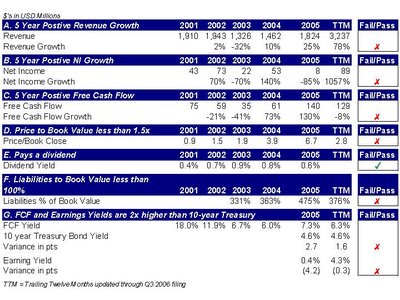
Growth Assessment
With my growth reviews of stock, I use a few different valuation techniques to surround my assumptions.
- 5 Year Discounted Cash Flow model with terminal value
- Industry Price to Earnings multiples
- Industry Price to Sales multiples
- Current Price to Earnings sensitivity
From a growth perspective, there is some potential upside to the current market cap value. This is mainly driven by the Price/Sales ratio that I am using from the Morningstar website at 1.4x. If I use a 0.7x price to sales ratio that the stock is currently trading at, the overall growth market cap is 2,089 or 1.2% upside opportunity to the current trading levels.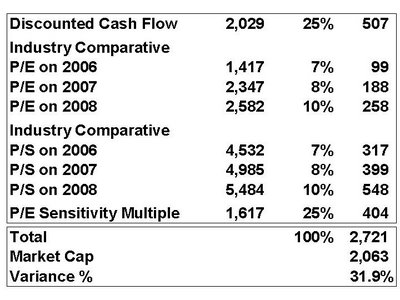
DCF Model
In my 5 year discounted cash flow model, I am assuming 10% sales growth with net income margin improving to 4.1% and the free cash flow % to revenue of 6.0%, compared to 2.8% and 4.0% on a TTM basis. With a corresponding 5% terminal value and 10% cost of capital, WLT’s value is worth around $2.0 Billion.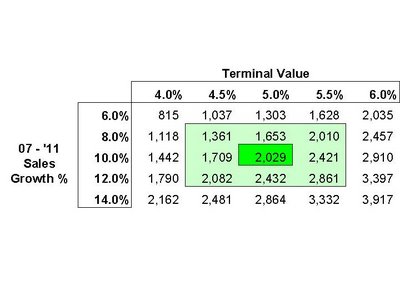
Industry P/E and P/S multiples
With the diversified portfolio of Walter Industries, I have elected to capture the Morningstar.com industry benchmarks for Price to Earnings of 15.9x and 1.4x respectively. As previously mentioned, the 1.4x Price to sales benchmark is creating a potential growth opportunity for WLT. When you hold the 0.7x of Price to Sales the current stock is trading at, the potential growth has disappeared.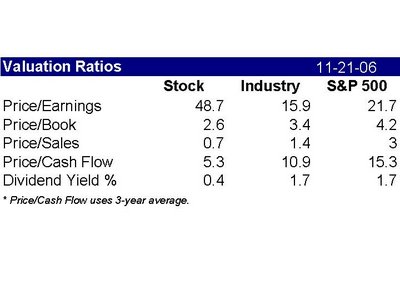
Current P/E sensitivity
With the Morningstar.com benchmarks, you will notice the Walter Industries is currently trading at 48.7x to earnings per share with the industry trading at 15.9x. I have selected a P/E of 15.0 to capture the market cap sensitivity on project future earnings growth of 10%. 
Sources:
Company Website
Edgar Online database
Yahoo Finance Website
Morningstar Website
GOOG vs. YHOO – Main Event
Internet Giants Heavyweight Championship
“Are you ready to rumble?”
Let’s first look at the company overview to provide you with a background of the companies.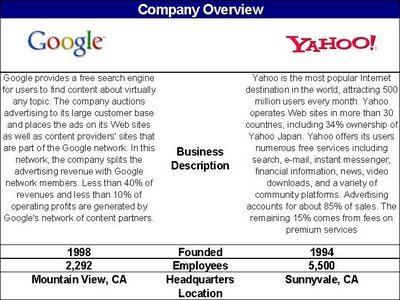
Round #1 - Income Statement, the clear winner is GOOG. With a commanding lead in all of the selected categories, the most impressive is the 5-year growth rate on revenue. In 2001, GOOG recorded $86MM of revenue compared to $717MM of revenue for YHOO. By the end of 2003, the two companies were almost equivalent in the amount of revenue recorded, with YHOO booking almost 2x of the net income. On a 2006 TTM basis, GOOG is recording approximately 33% more revenue than YHOO with an 800 basis point lead on margin, very impressive in the ability to drop most of the top line gains to the bottom line. To note, there are approximately one-time gains in YHOO’s 2005 financials that is reflecting the 2006 TTM annual growth rate to go negative.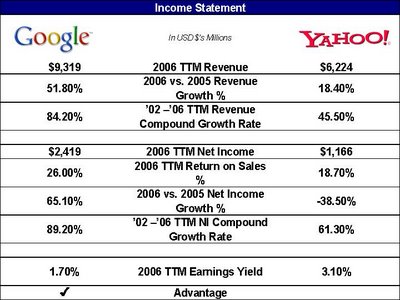
Below you will find the Financial Trend Charts that I typically provide:
GOOG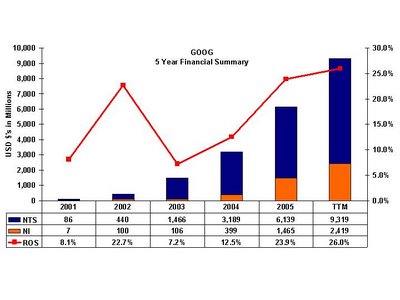
YHOO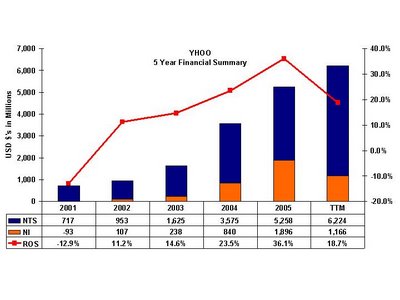
Round #2 - Balance Sheet & Cash Flow, I will rate a tie. GOOG is strong with the current ratio, net current assets, and the low amount of debt but YHOO is lower priced in the market with a better Price/Book and FCF yield. Either firm doesn’t pay a dividend. YHOO does carry some long-term debt on the books. Both firms can cover at least twice the level of the current liabilities, which doesn’t make them a concern for liquidity problems. In early October 2006, GOOG announced the acquisition of YouTube for $1.65 Billion in stock. I am surprised that GOOG decided to complete the acquisition with stock rather than use some of the $10.4 Billion in cash and marketable securities
What will GOOG do will all of that cash being generated???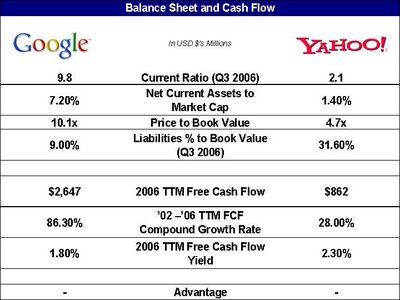
Round #3 – Growth & Valuation, YHOO currently holds some upside to the current trading levels. I am expecting GOOG to grow twice as fast as YHOO with both firms capturing approximately 30% of FCF to Revenue. Assuming a slightly higher WACC for Yahoo at 11.5% compared to GOOG’s 11.0% and both at 5% terminal value. With the above assumptions, GOOG is currently valuation is highlighting that these growth assumptions, and then some, are already priced into the market.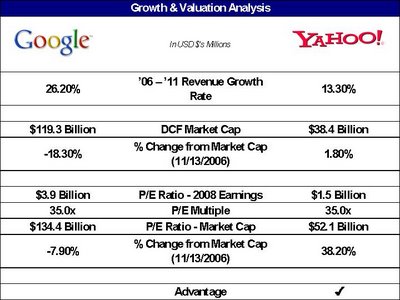
Sources:
Company websites
Edgar online database
Yahoo Finance
Morningstar
Barchart.com
Portfolio Decision: Added to the portfolio @ 73.73 per share on November 7th, 2006.








